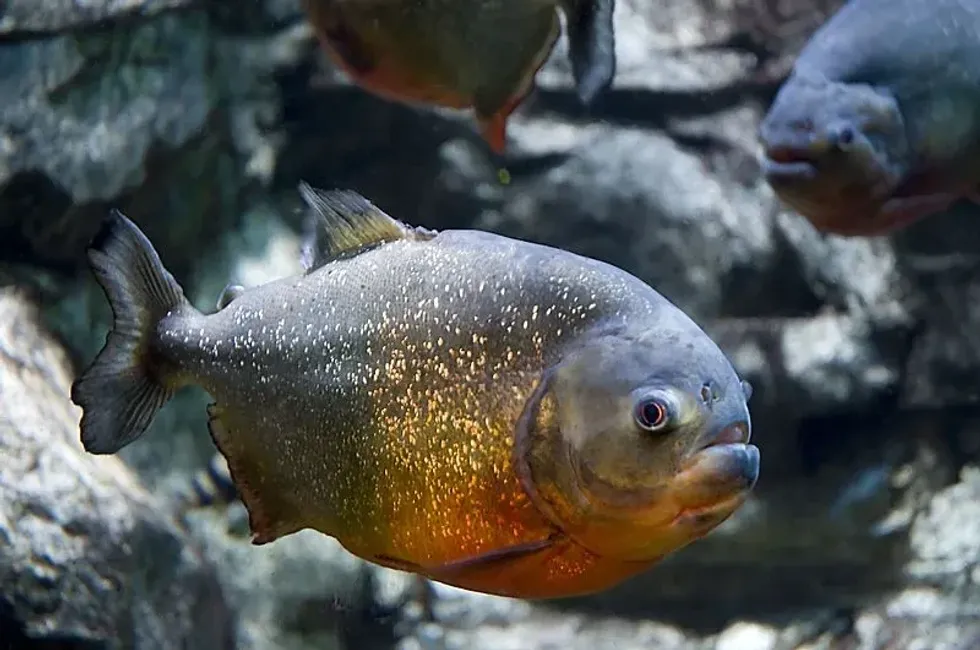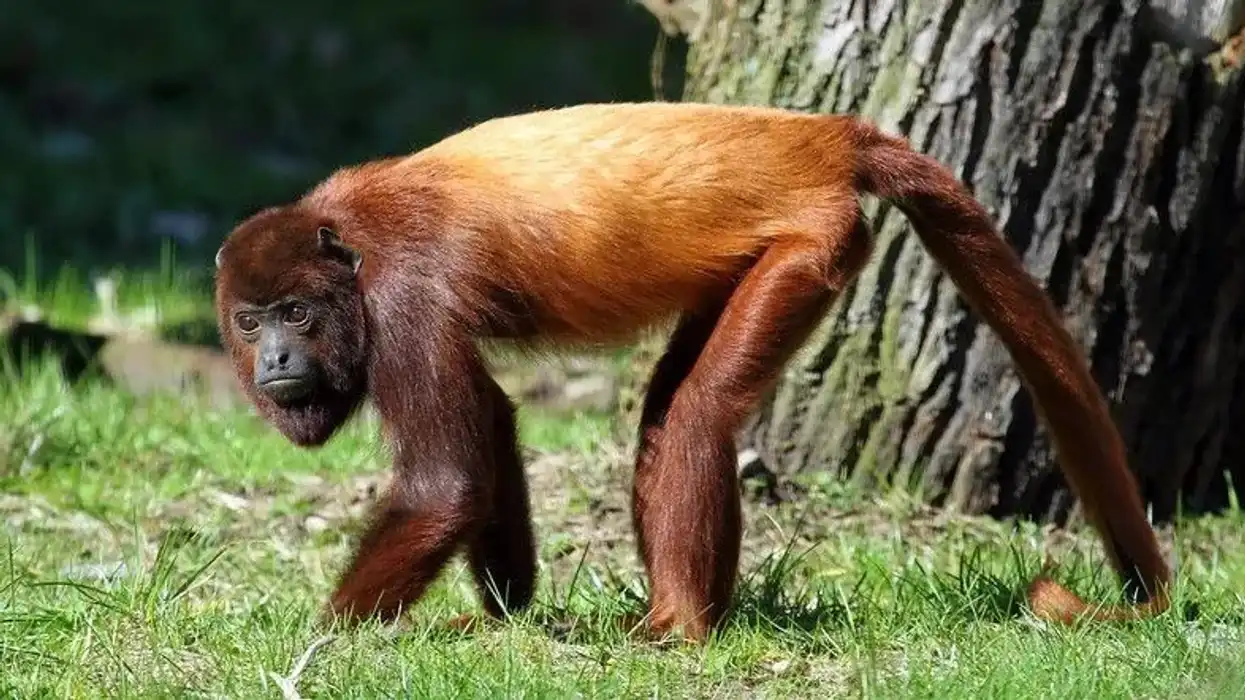Have you ever seen a red-bellied piranha (Pygocentrus nattereri) in an aquarium? Have you noticed its fast movements?
They are one of the freshwater aquarium fish that belong to the species of piranha and are native to the Amazon River basin. Red-bellied piranhas are known to be ferocious predators and pack hunters. When living in the wild, their diet consists of fins that have been nipped from the tails of larger fish species.
Their sharp teeth are fully capable of even slicing through the bone of their prey. Their taxonomy is continually being revised, with Serrasalmus and Pristobrycon, in particular, presenting several problems with identification.
This fish from the genus Pygocentrus spends most of its time roaming around throughout South American waters while hunting for food. Here are some fun, engaging, and interesting facts on red-bellied piranhas. Afterward, do check our other articles on Texas cichlid facts and Pacific salmon facts.
Red-Bellied Piranha Interesting Facts
What type of animal is a Red Bellied Piranha?
The red-bellied piranha (Pygocentrus nattereri), or red piranha, is a freshwater fish that belongs to the species of piranha. These wild fishes are spread throughout the continent of South America. These fishes are seen in Panama, Paraguay, and the Amazon basins.
They are not migratory species and are scavengers of the Amazon basin ecosystem. They are popular aquarium fishes. A red-bellied piranha or red piranha is called one of the most ferocious fish in the world.
What class of animal does a Red Bellied Piranha belong to?
The red-bellied piranha (Pygocentrus nattereri) is a species of piranha fish that belongs to the Actinopterygii class. Red Bellied Piranha comes under characiformes order in the serrasalmidae family. These fishes are widely spread across the continent of South America. These fish are extremely popular as aquarium fish species. It is known as a rapacious predator.
How many Red-Bellied Piranhas are there in the world?
The red-bellied piranha is a very common species and locally abundant. There are no accurate estimates of the total number of red-bellied piranhas in the world. As these aquatic animals have a good population, their number is steadily increasing.
Where does a Red Bellied Piranha live?
Red-bellied piranhas are widely spread across the continent of South America; including Paraguay, Argentina, Brazil, Peru, Guyana, and Bolivia. These aquatic animals are also found in the river basins of Amazon, Parana, Essequibo, and Paraguay as well as in the coastal part of southwest Brazil.
What is a Red-Bellied Piranha's habitat?
A red-bellied piranha's habitat comprises freshwater bodies. They are usually seen in whitewater but are also known to be found in clearwater and blackwater. A red piranha lives in lakes, rivers, streams, and floodplains. These aquatic animals are adaptable and are one of the popular aquarium fish.
Who do Red-Bellied Piranhas live with?
Red-bellied piranhas tend to live in groups. They usually tend to travel and hunt with a school of 20-30 fish.
How long does a Red Bellied Piranha live?
As the red-bellied piranha is a freshwater aquarium fish, the average red-bellied piranha's life span will vary between 10-15 years. They usually live around 10 years in captivity. It may vary according to the food habits and surroundings.
How do they reproduce?
Red-bellied piranhas usually breed when they are one year old. The courtship display is the first step of reproduction in red-bellied piranhas which involves swimming in circles. The eggs are laid on the sediment of the pit where it is fertilized as part of the reproduction process.
The nest is usually constructed along the margins of flooded areas. Then the nest is guarded by male fish whereas the female fish swim away. Around hundreds of fry are born in a single clutch.
What is their conservation status?
Red-bellied piranhas are a very common species and are found abundantly rather the market is flooded with them. As they have a good population, their number is steadily increasing. Hence, they do not face any extinction threats.
Red-Bellied Piranha Fun Facts
What do Red-Bellied Piranhas look like?

A red-bellied piranha is a freshwater aquarium fish that belongs to the species of piranha. The head of the fish is convex in shape.
The body of the red piranha is silvery gold with orange and red throat, anal fin, and belly and the back is in steel gray. Their lower jaw is like that of a bulldog and has interlocking teeth.
The red piranha’s body is thick and laterally compressed and covered with tiny scales and has a powerful tail that helps them to swim very fast. Like all the Characins, they also have an adipose fin between the tail and the dorsal fin.
How cute are they?
Even though the red piranha is an aquarium fish, it is less friendly compared to others and could be aggressive. Their lower jaw is like that of a bulldog, which can be a bit scary. They are not so cute in general.
How do they communicate?
Red piranhas are social fish and communicate with each other using sounds. They make a soft ‘croaking’ sound when they snap at each other and a drum-like sound against their opponents and also when fighting for food.
How big is a Red Bellied Piranha?
On an average scale, a red-bellied piranha has a length of 8-12 (20-30cm) in but can grow up to 20 in. It is 10 times bigger than a dwarf minnow fish.
How fast can a Red Bellied Piranha swim?
The red-bellied piranha has a streamlined body with tiny scales and a powerful tail which makes them a fast swimmer. The average speed of piranhas is between 15- 25 mph (10-15mph).
How much does a Red Bellied Piranha weigh?
A red-bellied piranha is a small to medium-sized fish that weighs around 8.5 lb (3.8kg). It may vary according to the food habits and surroundings.
What are the male and female names of the species?
Neither the males nor the females have sex-specific names.
What would you call a baby Red-Bellied Piranha?
A baby or juvenile red-bellied piranha is known as a fry.
What do they eat?
The red-bellied piranha is an omnivore which means their diet consists of plant products as well as meat. Their diet includes fruits, fish, crustaceans, plants, and seeds in the wild and frozen foods like crabs, rainworms, and prawns in captivity.
When living in the wild, their diet consists of fins that have been nipped from the tails of larger fish species. These fishes swim and hunt in groups known as shoals or schools. The main predators of red-bellied piranhas are crocodiles, Amazon river dolphins, and herons.
Are they dangerous?
Red-bellied piranhas are ferocious predators and are called pack hunters as they attack their prey in schools. Piranhas are very aggressive and are perfect specimens of dangerous fishes.
Would they make a good pet?
Red-bellied piranhas are popular aquarium fish. They are not best to keep in a community aquarium. Red-bellied piranha pets require proper care and hence you must undertake proper research before buying this fish. The red-bellied piranha's price in the US starts from $12-$15 per individual.
Did you know...
Red-bellied piranhas are consumed by humans in the Pantanal region of Brazil. Piranha soup is popular in the region and some choose to grill it on banana leaves. However, eating piranha is considered taboo in places like some parts of the Amazon.
What is the behavior of the Red Bellied Piranha?
Red-bellied piranhas always travel in a school of 20-30 fish and are called pack hunters as they attack their prey in groups. Piranhas spent most of their time hunting for food.
They should not be kept in community tanks as they are very aggressive. They chase each other and cause wounds.
Can a piranha eat a human?
Red-bellied piranhas do not eat humans unless they are already dead or deeply injured. They do attack humans and can cause major injuries.
Here at Kidadl, we have carefully created lots of interesting family-friendly animal facts for everyone to discover! Learn more about some other fish including Tiger Oscar Facts, or Neon Tetra Facts.
You can even occupy yourself at home by coloring in one of our free printable red-bellied piranha coloring pages.










